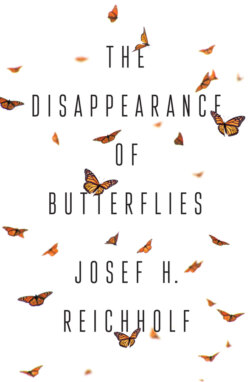Читать книгу The Disappearance of Butterflies - Josef H. Reichholf - Страница 22
The Strange Behaviour of the Purple Emperor
ОглавлениеThe purple emperor, with its tropical blue sheen, is surely among the most impressive of the butterflies that live in our part of the world. There are two species in central Europe, the large purple emperor, Apatura iris, and the lesser purple emperor, Apatura ilia, which is only somewhat smaller than the large one. The males of both species shimmer a magnificent indigo, just as if the upper side of their wings were underlaid with silver. With the females, the indigo is slightly less deep or virtually missing. There is also a special red variant of the lesser purple emperor, whose wings shimmer a dusky pink. It is rare for us, however, to come close enough to these masterpieces of our butterfly world to be able to admire them in all their living beauty, since they fly quickly and usually at quite a height. In Britain, the male purple emperor, A. iris, is referred to as ‘His Majesty’. For the many butterfly lovers there, sighting him represents the highlight of the butterfly year. They drive from near and far to the relatively few places in southern England where this treasure can be found with certainty.
In central Europe, both species of purple emperor can still be found quite regularly in early summer, between the end of June and the middle of August. The lesser purple emperor usually appears slightly earlier than its larger relative, usually from around mid-June. In particularly warm summers, such as 2018, one might even come across them at the beginning of June. Warmth always affects them. The main flying period for the larger purple emperor is the transition from June to July. The smaller species prefers the moister, warmer riparian woods, while the larger species favours logged forests – in southeast Bavaria, even forests dominated by spruce. If you did not know any better, you would be surprised to find the purple emperor in this type of managed woodland, which looks more like a plantation than a natural forest. But they are there, together with their smaller relatives, so that I need to inspect them closely in order to see which species they are when I set out to count the purple emperors along the forestry tracks. Often, I can already recognize the males of the larger purple emperor at quite a distance based on their distribution along the track. They sit right in the middle, at quite regular intervals of 20–30 metres – or every half kilometre, depending on how common or scarce they are in that particular year. From time to time, they fly up and perform an elongated oval over the forestry track, first in the direction of their neighbour on one side, then towards the other, which can sometimes lead to short aerial battles. Then the regular distribution pattern of the males is reproduced for a time. In other words, they claim a section of track as a territory that they defend against other members of their own species as well as against the lesser purple emperor, although less forcefully. If they are not close enough, they seem to be just as bad at differentiating these from their own species as we humans are. There is a marked, tooth-shaped point in the white stripe on the underside of the wing of the larger purple emperor, which disappears when the wings are closed, and which one can only make out when one is quite close. Similarly, the lesser purple emperor has another small ochre-coloured ‘eye’ on the lower outer edge of its forewing, and not just on the hindwing like the purple emperor.
I have always struggled to get close enough to this jewel of a butterfly to attempt a photograph: whenever I looked through the viewfinder of the camera and had the impression that I was close enough, had chosen the right section of the view and found the proper angle to capture the heavenly sheen, it would disappear with a barely perceptible wingbeat. Annoyed, and also ashamed of my slowness, I would later ascertain that on many such supposed butterfly pictures there would be nothing but the bare surface of the forestry track. Anyone who wants to take good photographs of such flighty beauties will need a lot of patience. Even then, it will barely suffice if you are not familiar with the behaviour of the butterfly and have no idea how it is influenced by the prevailing air temperatures or by the interplay of light and shadow in the forest. Early morning is the best time for photographs, when the sun is quite high and the butterflies are still numb from the cool and damp of the night. That said, at that time of day our purple emperors are usually still sitting in the unreachable heights of the treetops. Sometimes, one is simply lucky, and a photo comes out well. At other times, there might be special circumstances, such as those I once came across on a perfectly ordinary summer day in early July.
